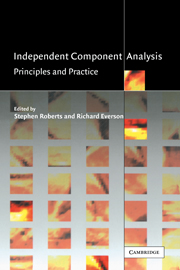Book contents
- Frontmatter
- Contents
- Preface
- Contributors
- 1 Introduction
- 2 Fast ICA by a fixed-point algorithm that maximizes non-Gaussianity
- 3 ICA, graphical models and variational methods
- 4 Nonlinear ICA
- 5 Separation of non-stationary natural signals
- 6 Separation of non-stationary sources: algorithms and performance
- 7 Blind source separation by sparse decomposition in a signal dictionary
- 8 Ensemble Learning for blind source separation
- 9 Image processing methods using ICA mixture models
- 10 Latent class and trait models for data classification and visualisation
- 11 Particle filters for non-stationary ICA
- 12 ICA: model order selection and dynamic source models
- References
- Index
12 - ICA: model order selection and dynamic source models
Published online by Cambridge University Press: 05 July 2014
- Frontmatter
- Contents
- Preface
- Contributors
- 1 Introduction
- 2 Fast ICA by a fixed-point algorithm that maximizes non-Gaussianity
- 3 ICA, graphical models and variational methods
- 4 Nonlinear ICA
- 5 Separation of non-stationary natural signals
- 6 Separation of non-stationary sources: algorithms and performance
- 7 Blind source separation by sparse decomposition in a signal dictionary
- 8 Ensemble Learning for blind source separation
- 9 Image processing methods using ICA mixture models
- 10 Latent class and trait models for data classification and visualisation
- 11 Particle filters for non-stationary ICA
- 12 ICA: model order selection and dynamic source models
- References
- Index
Summary
Introduction
In this chapter we investigate ICA models in which the number of sources, M, may be less than the number of sensors, N: so-called non-square mixing.
The ‘extra’ sensor observations are explained as observation noise. This general approach may be called Probabilistic Independent Component Analysis (PICA) by analogy with the Probabilistic Principal Component Analysis (PPCA) model of Tipping & Bishop [I9971; ICA and PCA don't have observation noise, PICA and PPCA do.
Non-square ICA models give rise to a likelihood model for the data involving an integral which is intractable. In this chapter we build on previous work in which the integral is estimated using a Laplace approximation. By making the further assumption that the unmixing matrix lies on the decorrelating manifold we are able to make a number of simplifications. Firstly, the observation noise can be estimated using PCA methods, and, secondly, optimisation takes place in a space having a much reduced dimensionality, having order M2 parameters rather than M × N. Again, building on previous work, we derive a model order selection criterion for selecting the appropriate number of sources. This is based on the Laplace approximation as applied to the decorrelating manifold. This is then compared with PCA model order selection methods on music and EEG datasets.
- Type
- Chapter
- Information
- Independent Component AnalysisPrinciples and Practice, pp. 299 - 314Publisher: Cambridge University PressPrint publication year: 2001
- 9
- Cited by

